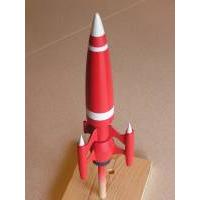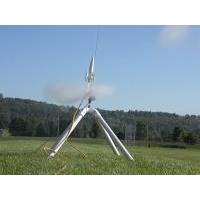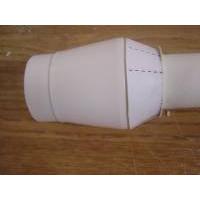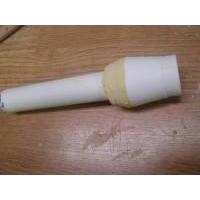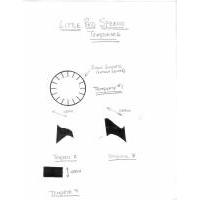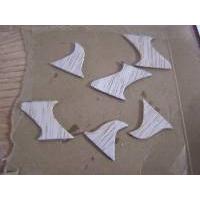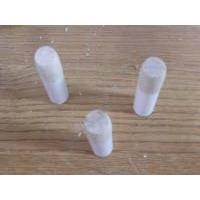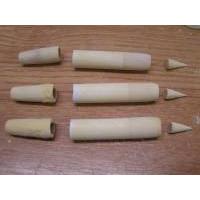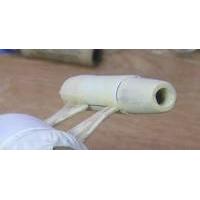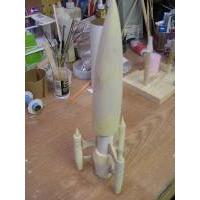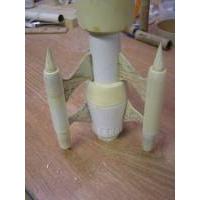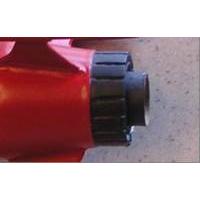Scratch Little Red Speedo Original Design / Scratch Built
Scratch - Little Red Speedo {Scratch}
Contributed by Ray King
| Overall Rating: | starstarstarstarstar_border |
| Published: | 2011-06-29 |
| Manufacturer: | Scratch |
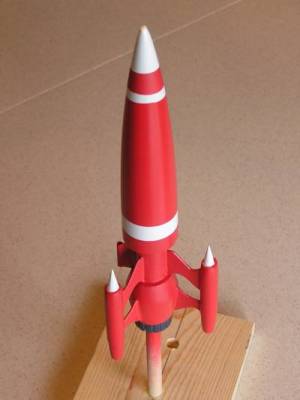 Brief
Brief
This is my submission for the EMRR Spaceship Design Competition as well as the EMRR Challenge #4. The rocket is designed to use an 18mm engine and 18” parachute recovery. OK – the name – My Little Red Speedo – Hey the rocket is red, it is small, it is fast, what better name to create a little attention.
Components
1 - BT-50 White Body Tube (9” Long)
3 - BT-5 White Body Tube (1.75” Long)
1 – BT-20 - 18mm Engine Tube (3.5” Long)
1 - 7” Plastic Nose Cone
1 - Launch Lug – 1” Long
2 - Centering Rings (BT-50 to BT-5)
1 - Centering Ring (OD
1 - Centering Ring (OD 1.20” ID.976”)
2 - Center Ring (OD 1.57” ID .976”) Thickness -.125”
1 - Centering Ring (OD 1.20” ID.976”)
1 - Balsa Center Ring (OD 1.30” ID .976”) Thickness -.125”
3/32” Balsa Sheet (See Templates) - Fins
1/2” Balsa Sheet – External Engine Pods
3 – BT-5 Balsa Nose Cones – External Engine Pods
3/8” Dowel - External Engine Pods Tips
Plastic Transition (T-55 to T-60 length is 1.25")
Nose Weight
36” of Kevlar Shock Cord
18” - 1/8” Shock Cord
18” Plastic Parachute
Construction
Main Body Tube Assembly:
Start with the BT-50 body tube, the BT-20 engine tube, appropriate centering rings, and Kevlar shock cord. Tie the Kevlar shock cord to the BT 20 tube and then slide on the centering rings on pulling the Kevlar under one of them (this will be the top of the engine mount assembly). Mount the centering rings on to BT-20 tube and then mount the assembly in the BT-50 allowing .25” of the engine tube assembly sticking out of the BT-50. Be careful with shock cord, mark sure it extends out the top end the through the body tube. Mark the BT-50 tube for 3 fins (120 Degrees apart) and launch lug between 1 set of fins. Also, mark locations at 4” and 6-7/8” round the top from the end with the engine mount.
 Lower Body Tube & Transition:
Lower Body Tube & Transition:
Now, modify the plastic transition by cutting the tip off of the small end (see picture), cut the large tube connection end off also. Now slide the appropriate rings on the tube that will support the transition. These may need to be sanded to improve fit. Next slide the centering ring in place for the front section. Make a card stock transition using the EMRR transition maker (http://www.delorie.com/rockets/transitions.html). Using the 5 min. epoxy secure the centering rings, plastic transition, and card stock transition. Once this is dry using watered down Elmer’s wood filler to smooth out the joints.
Lastly using the (Template #1) slide it on to the engine tube and mark the transition where the cuts need to be made (See picture).
Fin Mounting
 Next using the templates (Template 2 and 3) cut out the fins that hold external engine pods. Round the front and rear edges of each fin. Mount the front fins with 5 min epoxy to the body up tight to the transition. Using 2 - ¼” Balsa strips to mount lower fins. Clamp the 2 strips to the front fin, clamp the lower fin and glue in place on the transition.
Next using the templates (Template 2 and 3) cut out the fins that hold external engine pods. Round the front and rear edges of each fin. Mount the front fins with 5 min epoxy to the body up tight to the transition. Using 2 - ¼” Balsa strips to mount lower fins. Clamp the 2 strips to the front fin, clamp the lower fin and glue in place on the transition.
External Engine Pod Assemblies:
Start with the BT-5 tube cut to 1.75” long, insert 3 balsa nose cones and sand the point off of each until a flat of about .490” is remaining. Glue the noses cones in place. Now take the .5” balsa sheet mark the diameter of BT-5 tube, cut and sand tapering the remaining diameter slightly – I did this all by eye. In hindsight, a .5” dowel would work also and probably save some sanding. Next take the 3/8” dowel and sharpen to a point – I was able to use a manual pencil sharpener for this and it worked pretty well. Finally, I coated all the components with watered down Elmar’s Wood Putty and sanded smooth (this always seems to take me 2 or 3 times) and glued together.
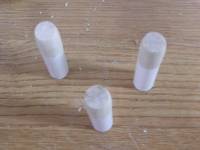 External Engine Pod Assembly to Main Body Tube
External Engine Pod Assembly to Main Body Tube
Draw a straight line the length of each of the external engine pod tubes. Align this line with the fins mounted on the main body tube and glue in place, I used CA for this. Once these were all mounted and dry I filleted each with 5 min epoxy to add more structural strength.
 Launch Lug
Launch Lug
Next glue the launch lug to the spacer (See Template 4) and glue this on the line between the two fins. Double check and make sure it is straight and fillet the assembly at the body tube using 5 min epoxy to improve joint strength.
Nose Cone Modification
When I first started this build I was using a balsa nose cone and after sanding almost all the balsa out of the inside to make room for the nose weight and body tube I realized I should just be using a plastic nose cone so I made a run to the hobby store and found one a liked. I removed the tube transition portion, sanded it smooth, added roughly and 1.5 oz of nose weight with a Kevlar shock cord. Make a loop in the shock cord; when gluing the nose weight lay the shock in the very front of the cone and cover all the nose weight with 5 min epoxy and drop into the cone ensuing they cover the cord completely. Should provide a secure attached for the weight and cord.
Nose Cone Centering Ring Location
Depending on the nose cone you chose the centering ring location may be slightly different then where the lines are located on the main body tube. Slide the largest ring on the tube and then slide the nose on to the tube assembly. Locate the ring where you want it and marked it. Remove the nose cone tape in place and now add the smaller diameter ring. Locate the ring at the top of the tube and slide the nose cone on until it is in its finally position – remove carefully not moving the centering ring. Mark it and do this a couple of times. When you have the same location a couple of times; glue it in place with 5 min epoxy.
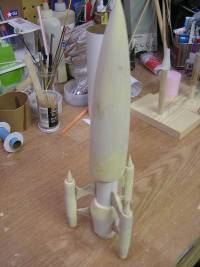 Finishing
Finishing
Finishing:
Well as with all these projects it seems to take longer to finish and paint it then building the rocket. I filled all the balsa components with watered down Emlar’s wood putty and sanded multiple times. I also filled some of the surface defects in the transition the same way.
After sanding I primer the entire rocket with Testor’s Model Master white primer and sanded, I repeated this a few more times. I then painted the entire rocket with Testor’s Model Master Gloss white color # 4696, masked the appropriate areas with Frog Tape (or Tamiya’ Masking Tape) and sprayed Testor’s Model Master “Rot RLM 23” color #2073. I masked the engine portion and painted with Model Master’s Engine Gray color #4749. After dry I sprayed the entire rocket with clear coat.
Flight
Flight / Recovery:
As with all my scratch builds I fly them before I start finishing and this was no exception. As I indicated above I started with a balsa nose cone, what I didn’t mention was that I also started with this rocket being 24mm engine – D12-5 or D12-7. I also always spin test each before I launched it also. After spinning this one and adding a ton of nose weight we were off to the launch field. I was a little concerned about this flight – the rocket blasted off the pad extremely fast -WOW!! Boost was OK a little unstable, but the ejection charge was so hard or the nose cone was so heavy a couple of the parachute lines broke. As it was falling I knew I was going to be rebuilding this one. Only minor damage occurred because of the long grass and soft ground!
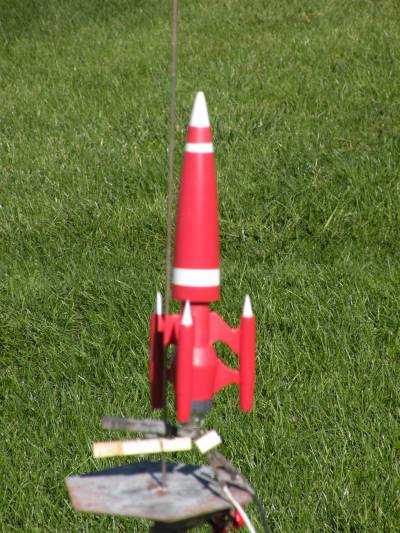
At this point, I downsized the engine and changed to a plastic nose cone, this reduced the nose weight by about half. I learned another lesson on this flight one that I have learned before but had forgotten – never, never, never put a centering ring at the bottom of the nose cone that will restrict the opening. The flight was good – nice boost, OK altitude, but the parachute stuck in the nose cone and never ejected – lawn darted on the only strip of sidewalk in the park – never fails – rocket and sidewalks are like tornados and trailer parks. OK rebuild time – lessons learned.
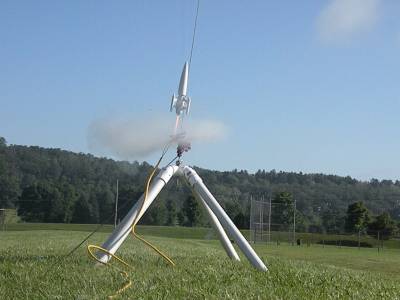
The next 3 flights were great – good boost with only a few twists, nice altitude, and good parachute deployment. Always seemed to have rough landings – may increase the chute size for the next launch.
Summary
After the few trials this is a nice little rocket with a name that makes people look every time it is launched.
Sponsored Ads
 |
 |
